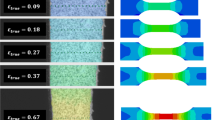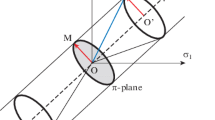Abstract
There exist numerous constitutive parameters in models used for the prediction of high strain-rate responses of metallic materials in the finite-deformation regime. Each of these parameters can possess various degrees of uncertainty, possibly due to (a) error in experimental measurements (b) a lack of consistent production methods or (c) the acquisition of data from different manufacturers. This communication investigates the overall system sensitivity that results, due to constitutive parameter uncertainty, when employing the commonly used Johnson-Cook class of high strain-rate ballistic models.
Similar content being viewed by others
References
Axelsson, O. (1994).Iterative solution methods. Cambridge University Press.
Follansbee, P. S. and Kocks, U. F. (1988). A constitutive description of the deformation of copper based on the use of the mechanical threshold stress as an internal state variable.Acta Metallurgica. Vol. 36, 81–93.
Johnson, G. R. and Cook, W. H. (1983). A constitutive model and data for metals subjected to large strains, high rates and high temperatures.Proceedings of the seventh international symposium on ballistics. The Netherlands, The Hague, 541–547.
Johnson, G. R. and Holmquist, T. J. (1988). Constitutive model constants.Journal of Applied Physics. Vol. 64, No. 8, 3901–3910.
Johnson, G. R. and Cook, W. H. (1985). Fracture characteristics of three metals subjected to various strains, strain-rates, temperatures and pressures.Engineering fracture mechanics. Vol. 21, No. 1, 31–48.
Lesuer, D. R. (2000). Experimental investigations of material models for Ti-6Al-4V Titanium and 2024-T3 Aluminum.DOT/FAA/AR-00/25, Report.
Lesuer, D. R., Kay, G. and LeBlanc, M. (1999). Modeling large strain, high rate deformation in metals. InEngineering research, development and technology, Lawrence Livermore National Laboratory,UCRL-53868-98.
Meyers, M. A. (1994).Dynamic behavior of materials. John-Wiley.
Naghdi, P. M. (1990). A critical review of the state of finite plasticity.Journal of Applied Mathematics and Physics (ZAMP). Vol 41, 315–394.
Steinberg, D. J. Cochran, S. G. and Guinan, M. W. (1979). A constitutive model for metals applicable at high-strain rate. Lawrence Livermore National Laboratory,UCRL-80465, Revision 2.
Zerilli, F. J. and Armstrong, R. W. (1987). Dislocation-mechanics-based constitutive relations for material dynamics calculations.Journal of Applied Physics. Vol. 61, No. 5. 1816–1825.
Zerilli, F. J. and Armstrong, R. W. (1990). Description of tantalum deformation behavior by dislocation mechanics based constitutive equations.Journal of Applied Physics. Vol. 68, No. 4. 1580–1591.
Zerilli, F. J. and Armstrong, R. W. (1992). The effect of dislocation drag on the stress-strain behavior of FCC metals.Acta Metallurgica et Materialia. Vol. 40, No. 8, 1803–1808.
Author information
Authors and Affiliations
Rights and permissions
About this article
Cite this article
Zohdi, T.I. On the sensitivity of a class of finite-deformation high strainrate ballistic models to constitutive parameter uncertainty. Int J Fract 119, 47–52 (2003). https://doi.org/10.1023/A:1023908426462
Issue Date:
DOI: https://doi.org/10.1023/A:1023908426462




